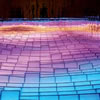The size of the picture and the form that it has, it´s what we call the basic plane, where all the other visual elements are contained. Every plane has some limits and a certain form that will influence the work itself, adding sensations. Especially because of the visual directions that move the viewer´s eye around the picture.
Normally we determined a format by the height and width, and we differentiate vertical, square, horizontal or landscape format.
What kind of format we would choose for our painting, it is closely related to the intention, to the searched expressiveness and, in short, to the communication itself that we will perform.
Analyzing these types of formats, the standards and the more common sizes, we can develop a list of the adjectives to define and understand them.
LIST OF SIZES

1- The vertical size
Properties or expressions that suggest: tall, strong, active, young, tight, interactive, dynamic, cheerful, cool, close, positive, upward…
The predominant vertical lines of this format make an unstable element that is easy to move vertically, as does the human figure. The vertical and movement are related.
Also, when as spectators, we put face to face a vertical picture, it ´s easier to establish a intellectual dialogue. We want to find their meanings, trying to understand their characters. It´s a stronger impulse and it demands attention. What sometimes results troublesome, according to the theme.
This size is widely used in portrait, because of the verticality that has an active human figure, and also, it connects very well with our own body size. And due to this relationship with us, it also serves for the exciting, life-giving or mysterious scenes.
2- The horizontal size
Properties or expressions that suggest: low, static, passive, old, relaxed, sad, distant, stable, conservative, negative, downward…
The skyline can be seen in this format, because its upper and lower limits, and this creates a base stability. We believe that what is lying on the ground still remains quiet, inert and controllable. We think that the horizontal line it´s not easy to put vertical and so we relax, because we don´t have to control a movement.
It is an ideal size for landscapes because nature itself is viewed with a horizon, below the stability, above the air, the flowing and the imagination.
It serves very well to create depth. And also a calm expression, in peace, and even, melancholy and sadness. It has more dramatic capacity, deep reflection and spiritual meditation.

3- The square size
Properties or expressions that suggest: strong or weak, active, expansive, large, stable, quiet, ascending, serene, positive energetic neutrality…
The square is an active size because there is not a lower horizontal where the view rests. But it is not very active because the vertical is short and is stable. Generates expansion to its limits on the one hand and introspection towards its center point, where the view comes to rest. Normally, in this size, the view search support points, so the view moves much throughout the space and flows for a while until, for the natural tendency, the eye finish on the bottom left.

4- The round size
Like the point, the circle or the sphere, the round size is balanced, expansive and dynamic at the same time. This format is known as the Zen or spiritual element, because of the concentration that achieved.

5- The triangular size.
This size contains directional lines which generates an outward movement in the view, and this may be harmful. Normally, the triangle can be used to activate more, to create visual games and to related forms. The triangle with the base well-established in its horizontal contains in the cross corner many vertical tip, that directs upward, so it can also serve to make spiritual messages and acute and distressing expressions.
6- Sizes with custom shapes.
If these sizes are related to the content and give it a sense, they can enhance very well the content itself and they can even create a correct visual harmony. Imagination allows us to create and convert to other sizes, and we can transform walls into canvases, with their resulting vertical and horizontal limits.
RELATIONS BETWEEN ELEMENTS AND BACKGROUNDS
There is a big difference between showing an element, a shape, in one size or another, complete or cut by the limits of the picture. The elements arranged in the picture exist in relation to the plane which contains them. The composition of the pictorial subject is always based on the plane that will contain all the elements, is its base.
If we analyze many famous paintings and modify their formats we would quickly changed its expressions. What once seemed asleep, we can wake up quickly, and vice versa, just by stretching a vertical or horizontal size.
Many mistakes can be avoided if we define first the expression we want in the work and then we choose the size of the picture according to it, otherwise, the size will fight against the expression and the other visual elements.
LIST OF SIZES FOR THE CANVAS
| Canvas sizes | ||
| Centimeters | Inches | |
| 12.5 x 12.5 | 5 x 5″ | |
| 15 x 15 | 6 x 6″ | |
| 17.5 x 12.5 | 7 x 5″ | |
| 20 x 20 | 8 x 8″ | |
| 25 x 20 | 10 x 8″ | |
| 25 x 25 | 10 x 10″ | |
| 30 x 25 | 12 x 10″ | |
| 30 x 30 | 12 x 12″ | |
| 35 x 25 | 14 x 10″ | |
| 35 x 35 | 14 x 14″ | |
| 40 x 30 | 16 x 12″ | |
| 40 x 40 | 16 x 16″ | |
| 45 x 15 | 18 x 6″ | |
| 45 x 35 | 18 x 14″ | |
| 45 x 45 | 18 x 18″ | |
| 50 x 20 | 20 x 8″ | |
| 50 x 40 | 20 x 16″ | |
| 50 x 50 | 20 x 20″ | |
| 60 x 25 | 24 x 10″ | |
| 60 x 30 | 24 x 12″ | |
| 60 x 45 | 24 x 18″ | |
| 60 x 50 | 24 x 20″ | |
| 60 x 60 | 24 x 24″ | |
| 75 x 30 | 30 x 12″ | |
| 75 x 50 | 30 x 20″ | |
| 75 x 60 | 30 x 24″ | |
| 75 x 75 | 30 x 30″ | |
| 90 x 30 | 36 x 12″ | |
| 90 x 45 | 36 x 18″ | |
| 90 x 60 | 36 x 24″ | |
| 90 x 75 | 36 x 30″ | |
| 90 x 90 | 36 x 36″ | |
| 100 x 30 | 40 x 12″ | |
| 100 x 40 | 40 x 16″ | |
| 100 x 50 | 40 x 20″ | |
| 100 x 70 | 40 x 28″ | |
| 100 x 75 | 40 x 30″ | |
| 100 x 100 | 40 x 40″ | |
| 110 x 60 | 44 x 24″ | |
| 120 x 30 | 48 x 12″ | |
| 120 x 60 | 48 x 24″ | |
| 120 x 75 | 48 x 30″ | |
| 120 x 90 | 48 x 36″ | |
| 120 x 120 | 48 x 48″ | |
| 125 x 100 | 50 x 40″ | |
| 150 x 40 | 60 x 16″ | |
| 150 x 75 | 60 x 30″ | |
| 150 x 100 | 60 x 40″ | |
| 150 x 120 | 60 x 48″ | |
| 180 x 60 | 72 x 24″ | |
| 180 x 90 | 72 x 36″ | |
| 180 x 120 | 72 x 48″ |








